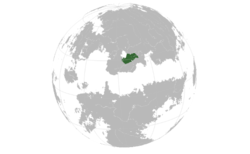Difference between revisions of "Komania"
| Line 1: | Line 1: | ||
{{Infobox country | {{Infobox country | ||
|conventional_long_name = The Great Nation of Komania | |conventional_long_name = The Great Nation of Komania | ||
|native_name = [[Koman language|Koman]]: Movat Xāza-sē Xālxāra <br>[[Balaki language|Balaki]]: Movas Hagzar Homançik <br> [[Mishar language|Mishar]]: Gálákál Sur-Gázuthö | |native_name = [[Koman language|Koman]]: Movat Xāza-sē Xālxāra <br> [[File:Mowat Qāza-sē Qālqāra.png|frameless|x23px]] <br> [[Balaki language|Balaki]]: Movas Hagzar Homançik <br> [[Mishar language|Mishar]]: Gálákál Sur-Gázuthö | ||
|common_name = Komania | |common_name = Komania | ||
|image_flag = Flag Komania.png | |image_flag = Flag Komania.png | ||
Revision as of 15:04, 11 November 2017
| The Great Nation of Komania |
||||||
|---|---|---|---|---|---|---|
|
||||||
| Motto: TBA Oh, thou my holiness! |
||||||
| Anthem: Osān Bivē Golden song |
||||||
| Capital | Shanvan | |||||
| Largest city | Sāmādar | |||||
| Official languages | Koman | |||||
| Recognised regional languages | Balaki, Mishar | |||||
| Ethnic groups | Koman (82 %) Other (18 %) |
|||||
| Religion | Thaghaism | |||||
| Demonym | Koman | |||||
| Government | Constitutional Monarchy | |||||
| - | Mişdar (emperor) | Mişanli Āşar | ||||
| - | Prime minister | Tāmeğa Bāşak | ||||
| Legislature | State Assembly | |||||
| Establishment | ||||||
| - | Kali Tribal Confederation | c.100 | ||||
| - | Kalkali | 700-1220 | ||||
| - | Sunrise Horde | 1220-1289 | ||||
| - | Great Horde | 1289- 1657 | ||||
| - | Oshar States | 1657 - 1769 | ||||
| - | Koman Empire | 1793 | ||||
| Area | ||||||
| - | 814.130 km2 314 sq mi |
|||||
| Population | ||||||
| - | 2016 estimate | 42,904,651 | ||||
| - | Density | 52.7/km2 136.5/sq mi |
||||
| Gini | 46 high |
|||||
| HDI (2016) | 0.786 high |
|||||
| Currency | Sexam | |||||
| Time zone | SCT +3 | |||||
| - | Summer (DST) | not observed (SCT) | ||||
| Drives on the | right | |||||
| Internet TLD | .km | |||||
The Great Nation of Komania (Koman: Movat Xāza-sē Xālxāra; IPA: [mofäθ xɒ:zäθə xɒ:lxɒrä]; Mishar: Gálákál Sur-Gázuthö) is a landlocked country bordered by Sotanxina and Azarmasi by the west, Nekhilia and Gushlia to the south and Balakia and Kaatkutia to the East. It is located along the Melkanchuta lake on the Vaniuan region ands is the homeland of the Koman people, a Vaniuan ethnic group. Its capital is the city of Shanvan, according to the 2016 census the total population is 42,904,651.
Etymology
The country is natively known as Xālxāra, Xālxāra; IPA: /xɒ:lxɒrä/; having the suffix -a meaning "place of" or "land of" being a variant of the suffix -dān leaving the root word as Xālxār, which is attested to have evolved from the tribal name Kalkali found written in several stelaes throughout the Golden steppes of Vaniua. According to the Boshom inscriptions found near the village of Şüğdar in the Bāşām province, the name is of tribal origin designating the Kalkali Empire and its people, having possible roots with their forefathers the nomadic Kali who roamed the Golden steppes c.100 and could have once inhabited the westernmost regions of the Miralaya, having derived from the name Kali probably meaning of the Kali or from the Kali having an attested pre-Vaniuan origin.
Modern Komans make use of varied alternative names to designate their land, most of them being poetic in nature, Hādağşēra "Land of black sands" being the most common term with Xārxāra and Qārāxār as variants from different dialects.
Komans traditionally use the tribal name "Xāman" meaning "of the ten" or "of the coast" to refer to themselves, with roots from the tribe of "Xām" who migrated from the Kalkali empire and established a short-lived tribal confederation around the coasts of Melkanchuta before being subjugated by the Great Horde.
History
Prehistory
The earliest evidence of human activity in the region has been dated back to around 100,000 BC and 90,000 BC during the Micoquien palaeolithic era with the discovery of archaeological artefacts throughout several regions of Komania, at that time, it is attested that the Melkanchuta lake formed a vast body of water which might have comprised the lower areas of the Vaniuan basin and most of its northern areas. The relatively dry but yet greenier area of the plateau served as an excellent refuge for early human settlements.
Geography
Located in the near centre of the Vaniuan region, Komania is considered a landlocked country, sharing the Melkanchuta lake with Dohjan the country extends itself along the Vaniuan plateau with a total area of 814.130km2.


